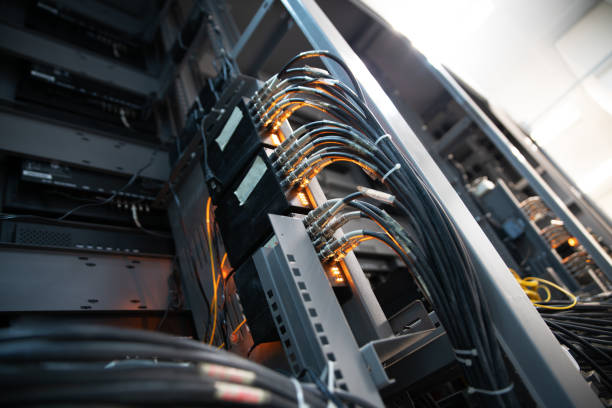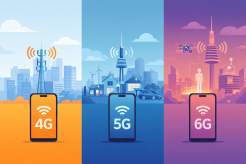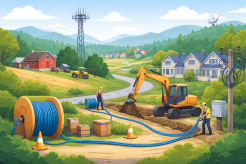Cable vs. DSL: Comparing Two Popular Internet Service Provider Types

Choosing the right internet service provider (ISP) is crucial in today's digital age. With numerous options available, it can be challenging to decide which one best suits your needs. Two of the most popular types are cable and DSL internet. Each has its own set of advantages and disadvantages, making the decision even more complex. This article will explore the differences between cable and DSL internet, helping you make an informed choice.
What is Cable Internet?
Cable internet is a type of broadband connection that uses the same coaxial cables as cable television. This technology allows for high-speed internet access, often providing faster speeds than DSL. The data is transmitted via a cable modem, which connects to the coaxial cable infrastructure that runs through neighborhoods.
What is DSL Internet?
DSL (Digital Subscriber Line) internet uses existing telephone lines to deliver high-speed internet. Unlike dial-up, DSL allows for simultaneous use of the internet and phone lines. The data is transmitted through a DSL modem connected to the phone line, providing an always-on internet connection.
Speed Comparison
Typical Speeds of Cable Internet
Cable internet typically offers download speeds ranging from 10 Mbps to 1 Gbps, depending on the plan and provider. This high-speed capability makes it suitable for activities like streaming, online gaming, and large file downloads.
Typical Speeds of DSL Internet
DSL internet speeds generally range from 1 Mbps to 100 Mbps. The speed varies based on the distance from the provider's central office, with closer locations receiving higher speeds. While slower than cable, DSL is still adequate for basic browsing, emailing, and streaming in standard definition.
Factors Affecting Speed in Both Services
Several factors can affect the speed of both cable and DSL internet, including network congestion, the quality of the infrastructure, and the number of connected devices in your home. Cable speeds can fluctuate during peak usage times, while DSL speeds can degrade over longer distances.
Reliability and Stability
Reliability of Cable Internet
Cable internet is generally reliable, but it can be affected by network congestion. During peak hours, when many users are online, speeds may decrease. Additionally, cable networks are more susceptible to outages caused by physical damage to the cables.
Reliability of DSL Internet
DSL internet is known for its consistent performance. Because it uses dedicated lines, DSL is less affected by network congestion. However, the quality and speed can diminish with increased distance from the provider’s central office.
Common Issues and Outages
Both cable and DSL internet can experience outages due to weather conditions, maintenance, or technical issues. Cable internet may also face disruptions if too many users are online simultaneously, while DSL can be impacted by line quality and distance from the service provider.
Availability and Coverage
Areas Where Cable Internet is Available
Cable internet is widely available in urban and suburban areas, where the infrastructure is well-developed. Rural areas might have limited or no access to cable internet due to the high cost of extending the network to less populated regions.
Areas Where DSL Internet is Available
DSL internet has broader availability, including many rural areas, as it utilizes existing telephone lines. However, the speed and quality may vary significantly depending on the distance from the provider’s central office.
Differences in Urban and Rural Coverage
In urban areas, both cable and DSL services are readily available, with cable often providing faster speeds. In rural areas, DSL is more commonly available, but speeds can be lower compared to urban offerings due to the infrastructure limitations.
Cost and Pricing
Typical Cost of Cable Internet
Cable internet plans can range from $30 to $100 per month, depending on the speed and provider. Higher speeds typically come with higher costs, and some providers offer bundled services that include TV and phone.
Typical Cost of DSL Internet
DSL internet is generally more affordable, with plans ranging from $20 to $70 per month. The cost can vary based on the speed and additional services, but it is typically less expensive than cable internet.
Hidden Fees and Contract Terms
Both cable and DSL providers may include hidden fees, such as installation charges, equipment rental fees, and early termination fees. It’s essential to read the fine print and understand the contract terms before committing to a plan.
Installation and Setup
Installation Process for Cable Internet
Installing cable internet usually involves a technician visiting your home to set up the modem and ensure proper connection to the coaxial cable infrastructure. This process can take a few hours, depending on the complexity.
Installation Process for DSL Internet
DSL internet installation can often be done by the user, as it involves connecting a DSL modem to the phone line. Some providers may offer professional installation, but it is generally simpler and quicker than cable installation.
Time and Complexity of Setup
Cable internet installation can be more complex and time-consuming, especially if additional wiring is needed. DSL installation is typically more straightforward and quicker, with most users able to complete the setup themselves.
Technology Behind Cable and DSL
Infrastructure of Cable Internet
Cable internet relies on a network of coaxial cables that deliver both television and internet services. This infrastructure supports high-speed data transmission but can be affected by network congestion and physical damage.
Infrastructure of DSL Internet
DSL internet uses the existing telephone network to deliver internet services. This infrastructure is widespread, making DSL available in many areas, but the technology has limitations in terms of speed and distance.
Technical Limitations and Advancements
Cable internet is limited by network congestion and the quality of the coaxial cables. Advancements like DOCSIS 3.1 have improved speeds and efficiency. DSL is limited by distance from the central office, but technologies like VDSL (Very-high-bit-rate DSL) have enhanced its performance.
Pros and Cons of Cable Internet
Advantages
- Higher speeds compared to DSL
- Widely available in urban and suburban areas
- Bundled services with TV and phone options
Disadvantages
- More expensive than DSL
- Speeds can fluctuate during peak hours
- Susceptible to physical damage and outages
Pros and Cons of DSL Internet
Advantages
- More affordable than cable
- Consistent speeds unaffected by network congestion
- Broad availability, including rural areas
Disadvantages
- Slower speeds compared to cable
- Performance decreases with distance from the central office
- Limited by the quality of the telephone line infrastructure
Which is Better for Streaming and Gaming?
Cable Internet for Streaming and Gaming
Cable internet is generally better suited for streaming and gaming due to its higher speeds and lower latency. This makes it ideal for high-definition streaming, online gaming, and downloading large files.
DSL Internet for Streaming and Gaming
DSL internet can handle basic streaming and gaming needs, but it may struggle with higher bandwidth activities. It’s more suitable for standard definition streaming and less intensive gaming.
User Experiences and Reviews
User experiences vary based on location and specific providers. Generally, users report better performance and satisfaction with cable internet for high-demand activities, while DSL is appreciated for its affordability and reliability.
Customer Service and Support
Support Quality of Cable ISPs
Customer service quality can vary among cable ISPs. Some users report satisfactory experiences, while others encounter long wait times and unresolved issues. Researching provider reviews can give insight into their support quality.
Support Quality of DSL ISPs
DSL ISPs also have varied customer service reputations. Some providers are known for responsive and helpful support, while others may lack in this area. Checking customer reviews can help gauge the quality of service.
Customer Satisfaction Ratings
Customer satisfaction ratings often favor ISPs that provide reliable service, transparent pricing, and effective customer support. Both cable and DSL providers have their strengths and weaknesses in these areas.
Future of Cable and DSL
Emerging Trends in Cable Internet
Emerging trends in cable internet include advancements like DOCSIS 4.0, which promises even faster speeds and improved network efficiency. Cable providers are also investing in expanding their infrastructure to offer gigabit speeds more widely.
Emerging Trends in DSL Internet
DSL technology continues to evolve with innovations like G.fast, which can significantly increase speeds over short distances. However, DSL is gradually being overshadowed by fiber optic technology, which offers much higher speeds.
Predictions for Future Developments
The future of internet connectivity may see a shift towards fiber optic and 5G technologies, which offer superior performance compared to cable and DSL. However, both cable and DSL will remain relevant, especially in areas where newer technologies are not yet available.
Making the Right Choice for Your Needs
When choosing between cable and DSL internet, consider the following factors:
- Speed Requirements: If you need high speeds for activities like streaming and gaming, cable may be the better option.
- Budget: DSL is generally more affordable, making it suitable for basic internet needs.
- Availability: Check which service is available in your area and compare the coverage.
- Customer Support: Research provider reviews to ensure good customer service.
- Future Plans: Consider whether you might benefit from future upgrades and advancements.
By evaluating your specific needs and circumstances, you can make an informed decision that best suits your internet usage.
Conclusion
In conclusion, both cable and DSL internet have their unique advantages and disadvantages. Cable internet offers higher speeds and is well-suited for bandwidth-intensive activities, while DSL provides consistent and affordable service with broad availability. Understanding the differences between these two options can help you choose the right internet service provider for your home or business.
Related Posts

Tue, Dec 30, 2025 10:21 PM
SafetyIs Your Phone Watching You? Real Signs and How to Lock It Down
Learn the real signs your phone may be spying on you, why it happens, and how to protect your privacy with practical, easy steps.

Tue, Dec 30, 2025 7:42 PM
TechnologyWhat Is the Difference Between 4G, 5G, and 6G?
Compare 4G, 5G, and 6G networks in terms of speed, latency, coverage, and real-world use cases, and understand how mobile connectivity is evolving.

Mon, Dec 29, 2025 10:35 PM
cheap internet dealsLock in Your Internet Bill for 5 Years With Xfinity (Yep, Really)
Lock in your internet bill for five years with Xfinity’s new price guarantee. Explore plans, speeds, perks, and why this offer stands out.

Mon, Dec 29, 2025 12:22 AM
Regulations TechnologyWhy Fiber Internet Still Hasn’t Reached Everyone Yet
Learn why fiber internet is still unavailable in many areas, from infrastructure costs to regulations, and what alternatives exist while waiting for expansion.

Fri, Dec 26, 2025 9:01 PM
cheap internet offersAre Data-Only Plans the Next Big Thing?
Explore why data-only plans are gaining popularity, their benefits for mobile users, and how they could change the way we stay connected.